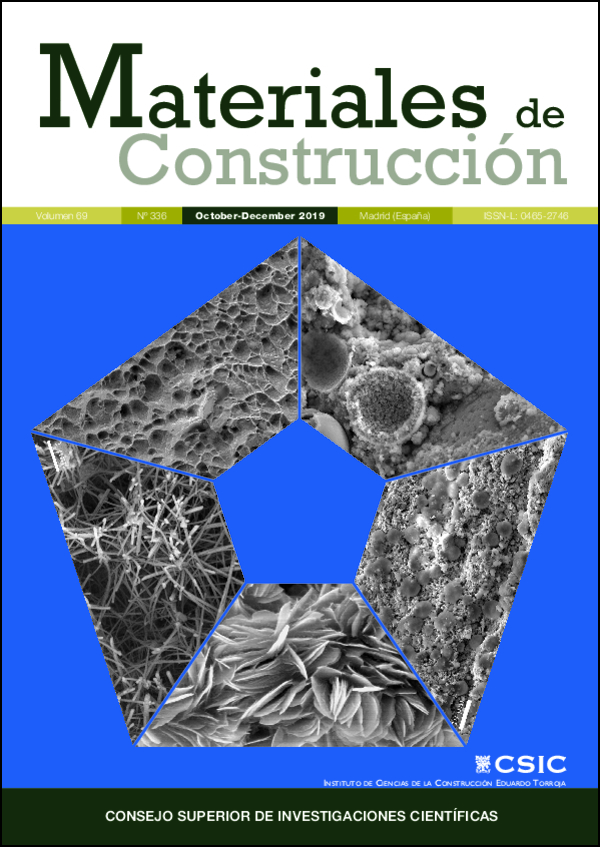Autoactivación de cemento de escorias con polvo de vidrio de descarte
DOI:
https://doi.org/10.3989/mc.2019.13618Palabras clave:
Cemento mezcla, Escoria, Vidrio, Activación alcalina, Espectroscopia infrarrojaResumen
El objetivo del presente trabajo es evaluar el comportamiento de un residuo molido de vidrio como activador interno de la escoria cuando ambos son usados en un cemento mezcla. El cemento de escoria fue preparado con un 70% de escoria y luego la escoria se reemplazó en un 10 y 20% en masa por vidrio molido. Este trabajo introduce el concepto de auto-activación. El vidrio molido libera álcalis por disolución, en forma lenta y sostenida en el tiempo que activarían la escoria. La presencia de vidrio molido mejora la fluidez de los morteros y la resistencia a compresión supera la dilución y crece con la edad por la acción puzolánica combinada de la escoria y el vidrio. El cemento mezcla propuesto tiene mejores propiedades mecánicas que el cemento de escorias pero con menor contenido de escoria por lo que es más sustentable y contribuye al manejo de residuos.
Descargas
Citas
Li, C.; Sun, H.; Li, L. (2010) A review: The comparison between alkali-activated slag (Si+Ca) and metakaolin (Si+Al) cements. Cem. Concr. Res. 40, 1341-1349. https://doi.org/10.1016/j.cemconres.2010.03.020
Menendez, G.; Bonavetti, V.L., Irassar, E.F. (2003) Strength development of ternary blended cement with limestone filler and blast-furnace slag, Cem. Concr. Compos. 25 [1] 57-63. https://doi.org/10.1016/S0958-9465(01)00056-7
Castellano, C.C.; Bonavetti, V.L.; Donza, H.A.; Irassar, E.F. (2016) The effect of w/b and temperature on the hydration and strength of blastfurnace slag cements, Constr. Build. Mater. 111, 679-688. https://doi.org/10.1016/j.conbuildmat.2015.11.001
García-Lodeiro, I.; Maltseva, O.; Palomo, A.; Fernández- Jiménez, A. (2012) Hybrid alkaline cements. Part I: fundamentals, Rom. J. Mater. 42 [4] 330-335.
Palomo, A.; Maltseva, O.; Garcia Lodeiro, I.; Fernandez Jimenez, A. (2013) Hybrid alkaline cements. Part II: the clinker factor, Rom. J. Mater. 43 [1] 74-80.
Angulo-Ramírez, D.E.; Mejía de Gutiérrez, R.; F. Puertas, (2017) Alkali-activated Portland blast-furnace slag cement: Mechanical properties and hydration, Constr. Build. Mater. 140, 119-128. https://doi.org/10.1016/j.conbuildmat.2017.02.092
Palomo Tomás, V.; Reciclar vidrio es ahorrar combustible. Available online: http://www.justoysustentable.org/2012/04/reciclar-vidrio-es-ahorrar-combustible.html. Acceded 24/06/2016.
Shi, C.; Zheng, K.; (2007) A review on the use of waste glasses in the production of cement and concrete, Resour. Conserv. Recyc. 52 [2] 234-247. https://doi.org/10.1016/j.resconrec.2007.01.013
Trezza, M.A; Rahhal, V.F. (2018) Behavior of the ground glass waste in blending cements: Comparative study with microsilice. Materia 23 [1]. https://doi.org/10.1590/s1517-707620170001.0311
Federico, L.M.; Chidiac, S.E. (2007) Waste glass as a supplementary cementitious material in concrete - Critical review of treatment methods, Cem. Concr. Compos. 31, 306-310.
Zhang, S.; Keulen, A.; Arbi, K.; Ye Zhang, G. (2017) Waste glass as partial mineral precursor in alkali-activated slag/ fly ash system. Cem. Concr. Res. 102, 29-40. https://doi.org/10.1016/j.cemconres.2017.08.012
Marchetti, G.; Rahhal, V.F.; Irassar, E.F. (2017) Influence of packing density and water film thickness on earlyage properties of cement pastes with limestone filler and metakaolin. Mat. Struct. 50 [2] 111. https://doi.org/10.1617/s11527-016-0979-1
Mostafá, N.Y.; El-Hernaly, S.A.S.; Al-Wakeel, E.I.; El-Korashy, S.A.; Brown, P.W. (2001) Characterization and evaluation of the hydraulic activity of water-cooled slag and air- cooled slag. Cem. Concr. Res. 31[6], 899-904. https://doi.org/10.1016/S0008-8846(01)00497-5
Torres-Carrasco, M.; Rodriguez-Puertas, C.; Alonso, M.M. (2015) Alkali activated slag cements using waste glass as alternative activators. Rheological behaviour. Bol. Soc. Esp. Ceram. Vidr. 54, 45-57. https://doi.org/10.1016/j.bsecv.2015.03.004
Bensted, J.; Varma, S.P. (1974) Some applications of infrared and Raman spectroscopy in cement chemistry. Part I- Examination of dicalcium silicate. Cement Technology, 256-261.
ASTM C1437-15, Standard Test Method for Flow of Hydraulic Cement Mortar
EN 196-5: Cements Test Methods: Pozzolanic test for Pozzolanic cements (in Spanish).
Shi, C.; Day, R. (1995). A calorimetric study of early hydration of alkali-slag cement, Cem. Concr. Res. 25 [6] 1333-1346. https://doi.org/10.1016/0008-8846(95)00126-W
Bakharev, T.; Sanjayan, J.; Cheng, Y-B. (1999) Álkali activation of Australian slag cements, Cem. Concr. Res. 29, 113-120. https://doi.org/10.1016/S0008-8846(98)00170-7
Mollah, M.Y.A.; Yu, W.; Schennach, R.; Cocke, D. (2000) A Fourier transforms infrared spectroscopic investigation of the early hydration of Portland cement and the influence of sodium lignosulfonate. Cem.Concr.Res. 30, 267-273. https://doi.org/10.1016/S0008-8846(99)00243-4
Puertas, F.; Torres-Carrasco, M. (2014) Use of glass waste as an activator in the preparation of alkali-activated slag. Mechanical strength and paste characterization. Cem.Concr.Res. 57, 95-104. https://doi.org/10.1016/j.cemconres.2013.12.005
Farcas, F.; Touzé, P. (2001) Infrared Fourier Transform (IRFT) spectrometry. A valuable technique for characterizing cement. Bulletin des Laboratories des Ponts et Chaussées. 230 [4350] 77-88.
Bensted, J.; Varma, S.P. (1977), Infrared and Raman spectroscopy in cement chemistry-miscellaneous applications. World Cement Technology 8 [1] 16, 18-20.
Mindess, S.; Young, J.F. (1981) Concrete, Cap.4. Prentice- Hall, New Jersey, 1981.
Publicado
Cómo citar
Número
Sección
Licencia
Derechos de autor 2019 Consejo Superior de Investigaciones Científicas (CSIC)

Esta obra está bajo una licencia internacional Creative Commons Atribución 4.0.
© CSIC. Los originales publicados en las ediciones impresa y electrónica de esta Revista son propiedad del Consejo Superior de Investigaciones Científicas, siendo necesario citar la procedencia en cualquier reproducción parcial o total.
Salvo indicación contraria, todos los contenidos de la edición electrónica se distribuyen bajo una licencia de uso y distribución “Creative Commons Reconocimiento 4.0 Internacional ” (CC BY 4.0). Consulte la versión informativa y el texto legal de la licencia. Esta circunstancia ha de hacerse constar expresamente de esta forma cuando sea necesario.
No se autoriza el depósito en repositorios, páginas web personales o similares de cualquier otra versión distinta a la publicada por el editor.
















